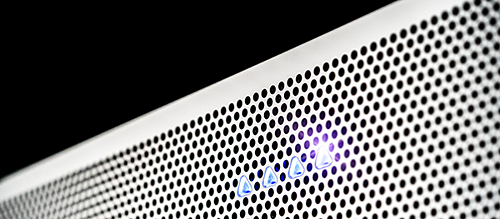After some time, when heated debates began about who is better, the no less well-known manufacturer ClearOne with its models of ceiling microphones appeared.

When ceiling mount arrays are applicable
Imagine a situation when you need to create a universal meeting room where you do not want to use table microphones in a wired or wireless conference system. To solve this problem, the installation of a ceiling microphone array is ideal. The table is free, no microphones - neither desktop, nor mortise, nor suspended. No need to cut the table and spoil the overall design of the room.
The question remains - which of the microphone arrays is better to use. The main task is to pick up a speech signal with minimal capture of spurious noise. How to determine which microphone is better - listen. The main component is the purity of speech removal without buzzing ventilation and other noises.
Shure MXA910
Shure initially entered the market with an excellent model, with an intuitive 8-beam adjustment interface, a customizable LED indicator, in 3 colors and three mounting options. It receives power via PoE, and sound is transmitted through Dante - all through a single twisted-pair cable.


Sennheiser TeamConnect Ceiling 2
Sennheiser in the first version received only analog audio transmission, but today a version with Dante and PoE is already presented. Sinheiser has a design in the form of two crossed lines, in which 28 omnidirectional microphones are installed. 4 LEDs indicate microphone status. Mounting options are similar, but the color scheme is the same - white. Optionally, you can order a different color from the RAL catalog.

To connect a microphone array via Dante - on the rear side of the device there are two RJ-45 ports for connecting the main and redundant channels. Also, sound can be sent in an analog way via a 3pin connector. Power is supplied through a separate RJ-45 interface, it also controls this device. The manufacturer also supplies management and configuration software.

That is, in any case, you will have to stretch two twisted pair cables - for sound, control and power, while Shure has only one. On the one hand - why more, when everything works on the same cable as practice shows, on the other hand - you can make a reservation.
The technical characteristics of the two models are very close. However, the MXA910 has customizable 8 beams, while TeamConnect has one beam that monitors a person. Thanks to customizable beams, and the possibility that the MXA910 system allows you to get this information, you can configure, for example, auto-guiding cameras by voice to the speaker.
ClearOne - BMA CT
ClearOne's ceiling-mounted microphone array appeared on the market relatively recently, but according to the declared characteristics, manufacturers have stepped far forward. The design remained with a perforated grille with LEDs and standard tile sizes.

The connection sockets on the rear side of the microphone are as follows: 1xRJ-45 for power supply via PoE and control, 2xRJ-45 - P-Link In and P-link Out for connecting several microphones in a chain and an additional built-in 2x10W amplifier for low-impedance (8 Ohm) speakers .

Minor Ceiling Microphone
With the main task - picking up a speech signal, all microphones cope, some are better, some are worse - this can be determined in each specific situation and in real tests.
However, if the equipped room is a room of 20-30 m2 or has a complex shape with columns, a presidium, and so on - additional speakers will need additional amplification, therefore it is necessary to equip the room with acoustic systems. Ceiling, wall, distributed speakers or linear arrays will be used - it does not matter, for a competent approach you will need to somehow separate the speakers into groups and disconnect part of the speakers so that the system does not start.
For example, the Shure MXA910 Ceiling Microphone Array uses 8 custom beams to capture audio. The number of rays and their location can be configured in the software . The functionality of the microphone system allows you to determine the active beam, that is, the area in which the person is located.

The ideal option is to rebuild the eight beams of the microphone array so that there are no intersections with the speakers of the speakers. But in practice - for the proper placement of speakers and ceiling microphone arrays - this condition is extremely difficult to fulfill. So the microphone beams will have intersections with the speakers of the speakers.
A simple solution is to divide the speakers into groups and turn off those speaker groups where the person is currently speaking. By determining the active beam of the microphone array - you can turn off the speaker column located in the beam area, thereby removing the possibility of starting the sound reinforcement system.
The final touch remained - to find a suitable amplifier so that it was not redundant, but at the same time was sufficient and had the ability to connect up to 8 channels. A well-known manufacturer of switching equipment Extron has an amplifier for both low-impedance and translational acoustics - XPA U 358.

The amplifier allows you to connect 8 channels of 35W, which is enough to connect 2-3 speakers in one line. If there are a lot of 8 channels, there are the same amplifiers with 4 channels for smaller halls.
In total, having one or more Shure MXA910 ceiling arrays, the required number of speakers, an amplifier for 4 or 8 channels and a control system - you can get excellent sound performance without the use of complex wiring diagrams and detuning equipment, thanks to the separation of beams and speakers into groups.